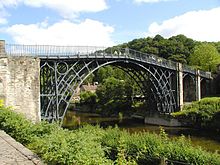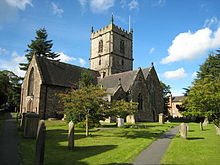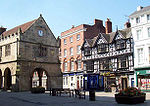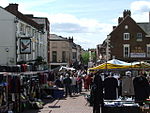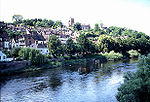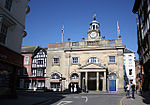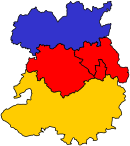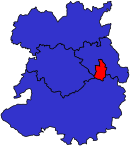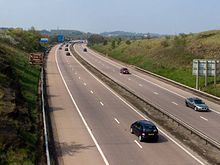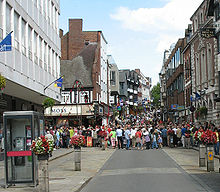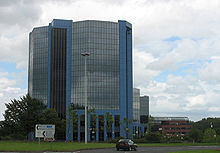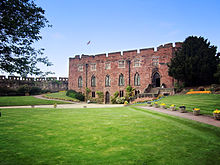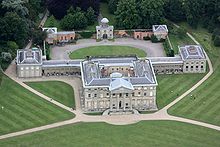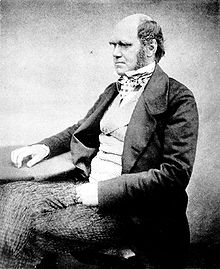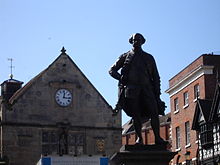- Shropshire
-
This article is about the English county. For other uses, see Shropshire (disambiguation).
Shropshire 
Motto of County Council:
Floreat Salopia
Geography Status Ceremonial county & (smaller) Unitary district Origin Historic Region West Midlands Area
- Total
- Admin. council
- Admin. areaRanked 13th
3,487 km2 (1,346 sq mi)
Ranked 4th
3,197 km2 (1,234 sq mi)Admin HQ Shrewsbury ISO 3166-2 GB-SHR ONS code 00GG NUTS 3 UKG22 Demography Population
- Total (2010 est.[1])
- Density
- Admin. council
- Admin. pop.Ranked 42nd
456,000
131 /km2 (340 /sq mi)
Ranked 28th
293,400Ethnicity 97.3% White
1.2% S.AsianPolitics No county council

Shropshire Council
http://www.shropshire.gov.uk
_______ 
Telford and Wrekin Council
http://www.telford.gov.ukExecutive Conservative Members of Parliament 5Districts 
- Shropshire Council (unitary)
- Telford and Wrekin (unitary)
Shropshire (
 /ˈʃrɒpʃər/ or /ˈʃrɒpʃɪər/; alternatively Salop;[7] abbreviated, in print only, Shrops[8]) is a county in the West Midlands region of England. For Eurostat purposes, the county (less the unitary district of Telford and Wrekin) is a NUTS 3 region (code UKG22) and is one of four counties or unitary districts that comprise the "Shropshire and Staffordshire" NUTS 2 region. It borders Wales to the west. Shropshire is one of England's most rural and sparsely populated counties with a population density of 91/km2 (337/sq mi).[9] The shire county and its districts were replaced by a unitary authority on 1 April 2009. The borough of Telford and Wrekin, included in Shropshire for ceremonial purposes, has been a unitary authority since 1998.[10]
/ˈʃrɒpʃər/ or /ˈʃrɒpʃɪər/; alternatively Salop;[7] abbreviated, in print only, Shrops[8]) is a county in the West Midlands region of England. For Eurostat purposes, the county (less the unitary district of Telford and Wrekin) is a NUTS 3 region (code UKG22) and is one of four counties or unitary districts that comprise the "Shropshire and Staffordshire" NUTS 2 region. It borders Wales to the west. Shropshire is one of England's most rural and sparsely populated counties with a population density of 91/km2 (337/sq mi).[9] The shire county and its districts were replaced by a unitary authority on 1 April 2009. The borough of Telford and Wrekin, included in Shropshire for ceremonial purposes, has been a unitary authority since 1998.[10]The county is centred on six main towns starting with the county town of Shrewsbury, which is culturally and historically important,[11] although Telford, which was constructed around a number of older towns, most notably Wellington, Dawley and Madeley, is today the most populous.[12] The other main towns are Oswestry in the north-west, Newport to the east, Bridgnorth in the south-east, and Ludlow to the south. Whitchurch and Market Drayton in the north of the county are also of notable size.
The Ironbridge Gorge area is a UNESCO World Heritage Site, covering Ironbridge, Coalbrookdale and a part of Madeley.[13] There are, additionally, other notable historic industrial sites located around the county, such as Broseley, Snailbeach and Highley as well as the Shropshire Union Canal.[14]
The Shropshire Hills Area of Outstanding Natural Beauty covers about a quarter of the county, mainly in the south.[15] The Wrekin is one of the most famous natural landmarks in the county,[16] though the highest hills are the Clee Hills,[17] Stiperstones[18] and the Long Mynd.[19] Wenlock Edge is another significant geographical and geological landmark.[20] In the low-lying northwest of the county (and overlapping the border with Wales) is the Fenn's, Whixall and Bettisfield Mosses National Nature Reserve, one of the most important and best preserved bogs in Britain. The River Severn, Great Britain's longest river, runs through the county, exiting into Worcestershire via the Severn Valley. Shropshire is landlocked, and with an area of 3,197 square kilometres (1,234 sq mi),[9] is England's largest inland county.[21]
The County flower is the round-leaved sundew. [22]
Contents
History
Main article: History of ShropshireThe area was once part of the lands of the Cornovii, which consisted of the modern day counties of Cheshire, Shropshire, north Staffordshire, north Herefordshire and eastern parts of Powys. This was a tribal Celtic iron age kingdom. Their capital in pre-Roman times was probably a hill fort on The Wrekin. Ptolemy's 2nd century Geography names one of their towns as being Viroconium Cornoviorum (Wroxeter), which became their capital under Roman rule and one of the largest settlements in Britain. After the Roman occupation of Britain ended in the 5th century, the Shropshire area was in the eastern part of the Welsh Kingdom of Powys; known in Welsh poetry as the Paradise of Powys. It was annexed to the Saxon kingdom of Mercia by King Offa in the eighth century, at which time he built two significant dykes there to defend his territory against the Welsh or at least demarcate it. In subsequent centuries, the area suffered repeated Danish invasion, and fortresses were built at Bridgnorth and Chirbury.[23]
After the Norman Conquest in 1066, major estates in Shropshire were granted to Normans, including Roger de Montgomerie, who ordered significant constructions, particularly in Shrewsbury, the town of which he was Earl.[24] Many defensive castles were built at this time across the county to defend against the Welsh and enable effective control of the region, including Ludlow Castle[25] and Shrewsbury Castle.[26] The western frontier with Wales was not finally determined until the 14th Century. Also in this period, a number of religious foundations were formed, the county largely falling at this time under the diocese of Hereford and that of Coventry and Lichfield. Some areas in later times fell under the diocese of St. Asaph until it ceased to exist in 1920.
The county was a central part of the Welsh Marches during the medieval period and was often embroiled in the power struggles between powerful Marcher Lords, the Earls of March and successive monarchs.[27]
The county also contains a number of historically significant towns, including Shrewsbury, Ludlow and Oswestry. Additionally, the area around Coalbrookdale in the county is seen as highly significant, as it is regarded as one of the birthplaces of the Industrial Revolution. The village of Edgmond, near Newport, is the location of the lowest recorded temperature (in terms of weather) in England and Wales.[28]
Etymology
The origin of the name "Shropshire" is the Old English "Scrobbesbyrigscīr" (literally Shrewsburyshire).
Salop is an old abbreviation for Shropshire, sometimes used on envelopes or telegrams, and comes from the Anglo-French "Salopesberia". It is normally replaced by the more contemporary "Shrops" although Shropshire residents are still referred to as "Salopians".[7]
When a county council for the county was first established in 1888, it was called Salop County Council.[29] Following the Local Government Act 1972, Salop became the official name of the county, but a campaign led by a local councillor, John Kenyon, succeeded in having both the county and council renamed as Shropshire in 1980.[30]
County extent
The border with Wales was defined in the 16th century – the hundreds of Oswestry (including Oswestry) and Pimhill (including Wem), and part of Chirbury had prior to the Laws in Wales Act formed various Lordships in the Welsh Marches.
The present day ceremonial county boundary is almost the same as the historic one. Notably there has been the removal of several exclaves and enclaves. The largest of the exclaves was Halesowen, which became part of Worcestershire in 1844 (now part of the West Midlands county), and the largest of the enclaves was Herefordshire's Farlow in South Shropshire, also transferred in 1844, to Shropshire. Alterations have been made on Shropshire's border with all neighbouring English counties over the centuries. Gains have been made to the south of Ludlow (from Herefordshire), to the north of Shifnal (from Staffordshire) and to the north (from Cheshire) and south (from Staffordshire) of Market Drayton. The county has lost land in two places – to Staffordshire and Worcestershire.[31]
Geography
Geographically, Shropshire is divisible into two distinct halves – North and South. The county has a highly diverse geology. The West Midlands green belt extends into eastern Shropshire, covering an area north from Highley, to the east of Bridgnorth, north to the eastern side of Telford, leaving Shropshire eastwards alongside the A5. This encompasses Shifnal, Cosford and Albrighton, and various other villages paralleling Dudley and Wolverhampton.[32]
North Shropshire
The North Shropshire Plain is an extension of the flat and fertile Cheshire Plain. It is here that most of the county's large towns, and population in general, are to be found. Shrewsbury at the centre, Oswestry to the north west, Whitchurch to the north, Market Drayton to the north east, and Newport and the Telford conurbation (Telford, Wellington, Oakengates, Donnington and Shifnal) to the east. The land is fertile and agriculture remains a major feature of the landscape and the economy. The River Severn runs through the lower half of this area (from Wales in the west, eastwards), through Shrewsbury and down the Ironbridge Gorge, before heading south to Bridgnorth.
 The Wrekin is a prominent geographical feature located in the east of the county.
The Wrekin is a prominent geographical feature located in the east of the county.
The area around Oswestry has more rugged geography than the North Shropshire Plain and the western half is over an extension of the Wrexham Coalfield and there are also copper deposits on the border with Wales. Mining of stone and sand aggregates is still going on in Mid-Shropshire, notably on Haughmond Hill, near Bayston Hill and around the village of Condover. Lead mining also took place at Snailbeach and the Stiperstones, but this has now ceased. Other primary industries, such as forestry and fishing, are to be found too.
The A5 and M54 run from Wolverhampton (to the east of the county) across to Telford, around Shrewsbury parallel to the line of Watling Street an ancient trackway. The A5 then turns north west to Oswestry, before heading north into Wales in the Wrexham area. This is an important artery and the corridor is where most of Shropshire's modern commerce and industry is found, notably in Telford new town. There are also a number of railway lines crossing over the area, which centre at Shrewsbury. To the south west of Telford, near the Ironbridge Gorge, is Ironbridge Power Station.
The new town of Telford is built partly on a former industrial area centred on the East Shropshire Coalfield as well as on former agricultural land. There are still many ex-colliery sites to be found in the area, as well as disused mine shafts. This industrial heritage is an important tourist attraction, as is seen by the growth of museums in the Ironbridge, Coalbrookdale, Broseley and Jackfield area. Blists Hill museum and historical (Victorian era) village is a major tourist attraction as well as the Iron Bridge itself. In addition, Telford Steam Railway runs from Horsehay.
South Shropshire
- For information specifically on the Area of Outstanding Natural Beauty, see Shropshire Hills AONB.
South Shropshire is more rural, with fewer settlements and no large towns, and its landscape differs greatly from that of North Shropshire. The area is dominated by significant hill ranges and river valleys, woods, pine forests and "batches", a colloquial term for small valleys and other natural features. Farming is more pastoral than the arable found in the north of the county. The only substantial towns are Bridgnorth, with a population of around 12,000 people, Ludlow and Church Stretton. The Shropshire Hills AONB is located in the south-west, covering an area of 808 km2 (312 sq mi);[9] it forms the only specifically protected area of the county. Inside this area is the popular Long Mynd, a large plateau of 516 m (1,693 ft) and Stiperstones 536 metres (1,759 ft) high to the East of the Long Mynd, overlooking Church Stretton.
The A49 is the main road through the area, running north to south, from Shrewsbury to Herefordshire. A railway line runs through the area on the same route as the A49 with stations at Church Stretton, Craven Arms and Ludlow. The steam heritage Severn Valley Railway runs from Bridgnorth into Worcestershire along the Severn Valley.
Because of its valley location and character, Church Stretton is sometimes referred to as Little Switzerland. Nearby are the old mining and quarrying communities on the Clee Hills, notable geological features in the Onny Valley and Wenlock Edge and fertile farmland in the Corve Dale. The River Teme drains this part of the county, before flowing into Worcestershire to the South and joining the River Severn.
One of the Clee Hills, the Brown Clee Hill, is the county's highest peak at 540 metres (1,772 ft).[33] This gives Shropshire the 13th tallest hill per county in England.
South West Shropshire is a little known and remote part of the county, with Clun Forest, Offa's Dyke, the River Clun and the River Onny. The small towns of Clun and Bishop's Castle are in this area. The countryside here is very rural and is in parts wild and forested. To the south of Clun is the Welsh border town of Knighton.
Climate
The climate of Shropshire is generally moderate. Rainfall averages 760 to 1,000 mm (30 to 40 in), influenced by being in the rainshadow of the Cambrian Mountains from warm, moist frontal systems of the Atlantic Ocean which bring generally light precipitation in Autumn and Spring.[34] The hilly areas in the south and west are much colder in the winter, due to their high elevation, they share a similar climate to that of the Welsh Marches and Mid-Wales. The flat northern plain in the north and east has a similar climate to that of the rest of the West Midlands.
Being rural and inland, temperatures can fall more dramatically on clear winter nights than in many other parts of England. It was at Harper Adams University College, in Edgmond, where on 10 January 1982 the lowest temperature weather record for England was broken (and is kept to this day): -26.1 °C.
The only Met Office weather station in the county is located at Shawbury, which is in the north, between Shrewsbury and Market Drayton.
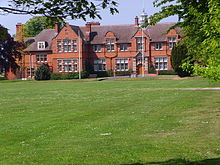 Harper Adams University College, where on 10 January 1982 the coldest temperature ever in England was recorded.
Harper Adams University College, where on 10 January 1982 the coldest temperature ever in England was recorded.
Month Jan Feb Mar Apr May Jun Jul Aug Sep Oct Nov Dec Year Avg. High (°C) 6.9
(L)7.3 9.7 12.1 15.7 18.3 20.9
(H)20.6 17.6 13.7 9.8 7.6 13.4
(AVG)Avg. Low (°C) 0.7 0.5
(L)2.1 3.2 6.0 8.9 11.0
(H)10.8 8.6 5.9 2.8 1.4 5.2
(AVG)Precipitation (mm) 58.5 42.9
(L)49.0 47.1 51.1 54.9 47.3 59.1 60.8 60.4 60.2 64.5
(H)655.7
(TOTAL)Sunshine (hours) 48.7 63.6 96.1 138.6 187.9 174.9 191.6
(H)172.7 126.3 94.9 61.5 41.5
(L)1398.1
(TOTAL)Wind at 10 m (knots) 9.0 8.9 9.3
(H)8.1 7.6 7.4 7.2 7.1
(L)7.3 7.4 7.9 8.6 8.0
(AVG)Source: Met Office - RAF Shawbury (1971–2000 averages)
RAF Shawbury is located approximately 7 miles (11 km) NE of Shrewsbury, and 12 miles (19 km) NW of Telford.Geology
The rocks in Shropshire are relatively new, especially compared to the Cambrian mountains. Shropshire has a number of areas with Silurian and Ordivician rocks, where a number of shells, corals and trilobites can be found. Mortimer Forest is an example where a number of fossils can be found.
Towns and villages
Further information: List of places in Shropshire, Category:Towns in Shropshire, and Category:Villages in ShropshireShropshire has no cities, but 22 towns, of which 2 can be considered major. Telford is the largest town in the county with a population of 138,241 (which is approximately 30% of the total Salopian populace); whereas the county town of Shrewsbury has a lower, but still sizeable population of 70,560 (15%). The other sizeable towns are Oswestry, Bridgnorth, Newport and Ludlow. The historic town of Wellington now makes up part of the Telford conurbation. The majority of the other settlements can be classed as villages or small towns such as Much Wenlock. The larger settlements are primarily concentrated in a central belt that roughly follows the A5/M54 roadway. Other settlements are concentrated on rivers, e.g. Ironbridge on the Severn, as these waterways were historically vital to trade.[35]
Telford
Ceremonial county of Shropshire
Telford and Wrekin shown within
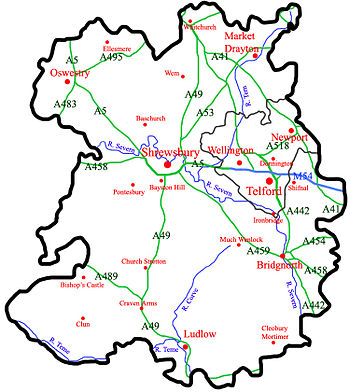
Rivers, Motorways, 'A' Roads, SettlementsTowns (by population):
Telford (138,241)
Shrewsbury (70,560)
Oswestry (15,613)
Bridgnorth (12,212)
Newport (10,814)
Ludlow (10,500)
Market Drayton (10,407)
Whitchurch (8,907)
Shifnal (7,094)
Bayston Hill (5,247)
Wem (5,142)
Broseley (4,912)
Church Stretton (4,186)
Albrighton (4,157)
Pontesbury (3, 500)
Ellesmere (3,223)
Much Wenlock (2,605)
Craven Arms (2,289)
Prees (2,688)
Bishop's Castle (1,630)
Ruyton-XI-Towns (1,500)
Baschurch (1,475)
Clun (642)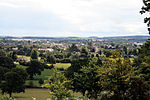
Newport
The town of Telford was created by the merger of older small towns surrounding the Wrekin. These towns now have sizeable populations that now make up the population of Telford, but still have unique characters, these are Wellington (20,430),[36] Madeley (17,935),[37] Dawley (11,399)[38] and Oakengates (8,517),[39] but the Telford and Wrekin borough towns incentive aims to make Oakengates into the largest of the towns.[40]
Politics
For Eurostat purposes, Shropshire County Council is a NUTS 3 region (code UKG22). The county has five parliamentary constituencies, four of which returned Conservative MPs at the 2005 general election and one, Telford, returned a Labour MP. This is a marked change from the 2001 general election result, where the county returned only one Conservative, three Labour and a Liberal Democrat to the Commons (see maps to the right) (Labour = Red, Conservatives = Blue and Liberal Democrats = Orange).
The current MPs of Shropshire are:
- David Wright, Labour, Telford (covering the town of Telford)
- Owen Paterson, Conservative, North Shropshire (covering the former North Shropshire and Oswestry districts, now coextensive with the North area committee)
- Philip Dunne, Conservative, Ludlow (covering the former South Shropshire and (the majority of) Bridgnorth districts; now coextensive with the South area committee except for the part covered by the Wrekin constituency)
- Daniel Kawczynski, Conservative, Shrewsbury and Atcham (covering the former Shrewsbury and Atcham district; now coextensive with the Central area committee)
- Mark Pritchard, Conservative, The Wrekin (covering Telford and Wrekin borough, minus Telford, and including a small area of the former Bridgnorth district/South area committee)
In 2005 there was also a County Council election in which the Conservatives gained overall control of the shire county. Telford and Wrekin Borough Council remained at the time under Labour control but has since gone to no-overall control, with a Conservative executive. Being a rural county, there are a number of independent councillors on the various councils in the county.[41]
The Conservatives gained complete control of Shrewsbury and Atcham Borough Council in the May 2006 local elections.
Constituency 1992 1997 2001 2005 2010 Ludlow CON Christopher Gill LD Matthew Green CON Philip Dunne North Shropshire CON John Biffen CON Owen Paterson Shrewsbury & Atcham CON Derek Conway LAB Paul Marsden LD Paul Marsden CON Daniel Kawczynski Telford LAB Bruce Grocott* LAB Bruce Grocott LAB David Wright The Wrekin LAB Peter Bradley CON Mark Pritchard - Note (*), The Wrekin (historic UK Parliament constituency) was split at the 1997 election.
Divisions and environs
See also: List of civil parishes in ShropshireMost of the ceremonial county of Shropshire is covered for purposes of local government by Shropshire Council, a unitary authority established in 2009. Telford and Wrekin is a unitary authority, with borough status, which forms part of the county for various functions such as Lord Lieutenant but is a separate local authority from Shropshire Council. However many services are shared across both authorities, such as the fire and rescue service, and the two authorities co-operate on some projects such as mapping flood risk.
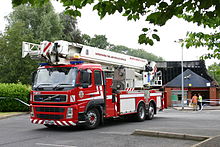 The whole county (including Telford and Wrekin) is served by the Shropshire Fire and Rescue Service.
The whole county (including Telford and Wrekin) is served by the Shropshire Fire and Rescue Service.
The ceremonial county borders Cheshire, Staffordshire, Worcestershire, Herefordshire, and the Welsh preserved counties of Powys and Clwyd.
The new unitary authority for Shropshire, Shropshire Council, divides the county into three areas, each with its own area committee – North, Central and South. These area committees, as well as relative staff, deal with local matters such as development control and licensing.
With the parishing of the formerly unparished area of Shrewsbury in 2008, the entire ceremonial county is now parished. The sizes of parishes varies enormously in terms of area covered and population resident. Shrewsbury is the most populous parish in the county (and one of the most populous in England) with over 70,000 residents, whilst Boscobel is the smallest parish in Shropshire by geographical area and by population, with just 12 residents according to the 2001 census.[42] The smaller parishes (with populations of less than 200) usually have a joint parish council with one or more neighbouring parishes, or in some instances, have a parish meeting (such as in Sibdon Carwood). The urban area of Telford is divided into many parishes, each covering a particular suburb, some of which are historic villages or towns (such as Madeley). The parish remains an important sub-division and tier of local government in both unitary authority areas of Shropshire.
Neighbouring Counties 
Wrexham/Clwyd Cheshire Staffordshire 
Powys 
Staffordshire  SHROPSHIRE
SHROPSHIRE 

Powys Herefordshire Worcestershire Local government 1974–2009
In 1974 the non-metropolitan county of Shropshire was constituted, covering the entire county. There was a two-tier system of local government, constituting a county council (as the upper tier) and six district councils – Bridgnorth, North Shropshire, Oswestry, Shrewsbury and Atcham, South Shropshire and The Wrekin. In 1998 The Wrekin became a unitary authority, administratively separate from the county council, and became Telford and Wrekin. The two-tier structure remained in the remainder of the county and was the least populated two-tier area in England.
Oswestry and Shrewsbury & Atcham were each granted borough status in 1974. Telford and Wrekin became a borough in 2002.
2009 restructuring
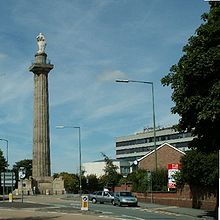 Shropshire's shirehall is located opposite the magnificent Lord Hill Column.
Shropshire's shirehall is located opposite the magnificent Lord Hill Column.
In 2006 a local government white paper supported proposals for new unitary authorities to be set up in England in certain areas. Existing non-metropolitan counties with small populations, such as Cornwall, Northumberland and Shropshire, were favoured by the government to be covered by unitary authorities in one form or another (the county either becoming a single unitary authority, or be broken into a number of unitary authorities). For the counties in the 2009 reorganisation, existing unitary authority areas within the counties' ceremonial boundaries (such as Telford and Wrekin) were not to be affected and no boundary changes were planned.
Shropshire County Council, supported by South Shropshire District Council and Oswestry Borough Council, proposed to the government that the non-metropolitan county of Shropshire become a single unitary authority. This was opposed by the other 3 districts in the county, with Shrewsbury & Atcham Borough Council taking their objection to the High Court in a judicial review.
The proposal to create a Shropshire unitary authority, covering the area of the existing non-metropolitan county, was supported by the DCLG and 1 April 2009 was set as the date for the re-organisation to take place. The first elections to Shropshire Council will not take place however until 4 June 2009, with the former Shropshire County Council being the continuing authority and its councillors became the first members of the new Shropshire Council on 1 April.
Part of the proposals include parishing and establishing a town council for Shrewsbury. The parish was created on 13 May 2008 and is the second most populous civil parish in England (only Weston-super-Mare has a greater population) with a population of over 70,000.
Transport
 The Shrewsbury and Newport Canal, Newport branch.
The Shrewsbury and Newport Canal, Newport branch. See also: Railways of Shropshire
See also: Railways of ShropshireShropshire is connected to the rest of the United Kingdom via a number of road and rail links. Historically, rivers and later canals in the county were used for transport also, although their use in transport is now significantly reduced. The county's main transportation hub is Shrewsbury, through which many significant roads and railways pass and join. Canals in the United Kingdom today serve primarily for leisure purposes and three British Waterways canals run through Shropshire: the Shropshire Union Canal (from north of Adderley to near Knighton), the Llangollen Canal (from Chirk Aqueduct to Grindley Brook) and the Montgomery Canal (from its beginning at Frankton Junction to Llanymynech). In addition, the Shrewsbury and Newport Canal potentially could be restored in the future.[43]
Major roads in the county include the M54 motorway, which connects Shropshire to the rest of the motorway network, and more specifically to the West Midlands county. The A5 also runs through the county, in an east-west direction. The road formerly ran through Shrewsbury, although a large dual-carriageway bypass has since been built. Other major trunk roads in the county include the north-south A49, the A53 and the A41.
There are a number of major railway lines running through the county, including the Welsh Marches Line, the Cambrian Line, the Shrewsbury to Chester Line and the Wolverhampton to Shrewsbury Line, as well as heritage railways including the well established Severn Valley Railway. The two train operating companies working in the county are London Midland and Arriva Trains Wales. A new company, Wrexham & Shropshire, commenced services from Shropshire to London Marylebone station, in spring 2008 but the service was discontinued on 28 January 2011 leaving Shrewsbury without a direct link to the capital.[44]
Two major water supply aqueducts run across Shropshire; the Elan aqueduct running through South Shropshire carrying water from Elan Valley to Birmingham and the Vyrnwy Aqueduct running through North Shropshire delivering water from Lake Vyrnwy to Liverpool.
Economy
Telford Plaza in Telford Town Centre.
 Beatties department store opened in 2004 at the west end of Telford Shopping Centre (Renamed House of Fraser in 2007).
Beatties department store opened in 2004 at the west end of Telford Shopping Centre (Renamed House of Fraser in 2007).
The economy of Shropshire was traditionally dominated by agriculture.[45] However, in more recent years it has become more service orientated. The county town of Shrewsbury, the historic castle-dominated Ludlow, the International Olympic Movement's birthplace Much Wenlock and the industrial birthplace of Ironbridge Gorge are the foremost tourist areas in Shropshire,[46] along with the reclaimed canal network which provides canal barge holidays on the Shropshire Union Canal and linked canal networks in the region, although the natural beauty of the county draws people to all areas.
Industry is mostly found in Telford, Oswestry, Whitchurch, Market Drayton and Shrewsbury, though small industrial estates can be found in and Church Stretton and Newport where the main industrial factory Audco, closed in 1982. The town has then started to move more towards an agricultural and tourist industry much like Ludlow, though industry is starting to build up along the outskirts of the town on the A41 road, because of its possession on the route between Wolverhampton, Birmingham, Staffordshire and the north. Shrewsbury is becoming a centre for distribution and warehousing, as it is located on a nodal point of the regional road network.[47][48]
In Telford, a new rail freight facility has been built at Donnington with the future goal of extending the line to Stafford, this is hoped it would open the freight terminal up to the East Midlands and the north, plus also re-connect Newport to the rail network.[48][49]
Telford and Shrewsbury are the county's two main retail centres, with contrasting styles of shopping – Shrewsbury's largely historic streets and Telford's large modern mall, Telford Shopping Centre.[50] Shrewsbury also has two medium-sized shopping centres, the indoor "Pride Hill" and "Darwin" centres (both located on Pride Hill),[51] and a smaller, partially covered, "Riverside Mall". Shrewsbury's situation of being the nearest substantial town for those in a large area of mid-Wales helps it draw in considerable numbers of shoppers, notably on Saturday.
Well-known companies in Shropshire include Müller Dairy (UK) Ltd in Market Drayton.[52] The RAF have two bases at RAF Cosford and RAF Shawbury,[53] and the charity PDSA has its head office in Priorslee, Telford.[54]
Statistics
Below is the chart of regional gross value added for the non-metropolitan county (that is, excluding Telford & Wrekin) of Shropshire at current basic prices published (pp. 240–253) by Office for National Statistics with figures in millions of British pounds sterling.
Year Regional Gross Value Added[55] Agriculture[56] Industry[57] Services[58] 1995 2,388 238 618 1,533 2000 2,977 177 739 2,061 2003 3,577 197 843 2,538 With the statistics for the borough of Telford and Wrekin included, the following represents the ceremonial county:
Year Regional Gross Value Added[55] Agriculture[56] Industry[57] Services[58] 1995 4,151 266 1,483 2,403 2000 5,049 197 1,512 3,340 2003 5,947 218 1,693 4,038 Education
Shropshire has a completely comprehensive education system, in the ceremonial county there are thirteen independent schools, including the prestigious Shrewsbury School, which Charles Darwin attended and Oswestry School, which is the second oldest school in the country, founded in 1407.
In the Borough of Telford and Wrekin borough has two selective schools, all of which are located in Newport, these are the Adams' Grammar School and Newport Girls' High School (both of which are ranked within the top thirty schools in the country), and the independent preparatory school Castle House, in Telford itself is the Thomas Telford School is also a notable school, ranked as one of the best comprehensive schools in England.[59] There is considerable rivalry between many of the county's schools. In Shrewsbury for example, the Priory and Meole Brace schools maintain a long-standing sporting rivalry whilst on a wider scale Wrekin College and Ellesmere College remain rivals, as do Shrewsbury School and Adams' Grammar School.
There are also two institutions of higher education in Shropshire, the Telford campus of Wolverhampton University and in Edgmond, near Newport, Harper Adams University College, which formerly offered mostly agriculture-based degrees but is expanding its range of provision.
In Ironbridge, the University of Birmingham operates the Ironbridge Institute in partnership with the Ironbridge Gorge Museum Trust, which offers postgraduate and professional development courses in heritage.
Shropshire has the highest educational attainment in the West Midlands region.[60]
List of schools in Shropshire Primary Comprehensive Abraham Darby Academy · Belvidere School · Bridgnorth Endowed School · Burton Borough School · Charlton School · Hadley Learning Community · Idsall School · Ludlow Church of England School · Marches School and Technology College · Oldbury Wells School · The Priory School · Thomas Telford School · Wakeman School and Arts College · William Brookes School of Arts and Technology
Further education colleges Sixth form colleges Ludlow College · New College Telford · Shrewsbury Sixth Form College
Grammar Independent (preparatory) Shrewsbury High Prep School Castle House School · Moor Park School · Packwood Haugh School · Prestfelde School
Independent (senior) Adcote School · Concord College · Ellesmere College · Moreton Hall School · Oswestry School · Shrewsbury High School · Shrewsbury School · Wrekin College
Universities Places of interest
Famous people
- Charles Darwin, eminent naturalist
- Robert Clive, "Clive of India"
- Billy Wright, "Born in Ironbridge, Wolverhampton Wanderers football player as well as England captain"
- Edric the Wild
- Rowland Hill, 1st Viscount Hill, Napoleonic era general
- Jonathan Corbett TV Presenter
- Lords and Ladies Craven (of Stokesay Castle)
- Abraham Darby, early industrialist
- Charles Babbage, early computing pioneer (lived at Dudmaston Hall)
- William Penny Brookes, founder Wenlock Olympian Games, founding father, International Olympic Movement
- K. K. Downing, guitarist with Judas Priest
- William Farr, epidemiologist and early bio-statistician
- Craig Phillips of Newport, winner of Big Brother 2000 (UK)
- Chris Hawkins (of Loppington), radio presenter, DJ, and celebrity
- Eglantyne Jebb of Ellesmere, social reformer and founder of the Save the Children Fund
- George Jeffreys of Wem, infamous judge
- Adrian Jones, sculptor of the Quadriga at Hyde Park Corner
- Sam Lees, statistician, produced notable work in collaboration with Peter Milner
- Stephen Marchant, ornithologist
- Peter Milner, statistician, produced notable work in collaboration with Sam Lees
- Len Murray, former head of the T.U.C.
- Mirabel Osler, author
- Wilfred Owen, leading First World War poet
- Edith Pargeter (1913–1995), author
- Edmund Plowden (1518–1585), legal scholar and theorist
- Sir Edmund Plowden (1590–1659), Proprietor, Earl Palatine and Governor of New Albion
- Barbara Pym, novelist
- Isobel Cooper (Izzy), famous opera singer from Much Wenlock
- T'Pau, 1980s pop group
- Sir Philip Sidney, prominent Elizabethan
- Mary Webb (1881–1927), author
- Stewart Lee, stand-up comedian, writer and director.
- Matthew Webb, first man to swim the English Channel
- Humphrey Kynaston (1474–1534), highwayman
- John Mytton, 'Mad Jack' Mytton, Regency rake, MP, gambler and horseman
- William Wycherley, Restoration dramatist and playwright famous for The Country Wife
- Roy Wood, of Wem, in the band Wizzard
- Jack Wilkinson, World Champion Lawn Bowler (originally from New Zealand)
- John Wilkinson, of Broseley, industrialist
- Alison Williamson, of Whitchurch Bowmen, Archery Olympic bronze medalist
- Lara Jones, of Telford, Writer of the Poppy Cat books
- Ivan Jones, of Telford, Writer of The Ghost Hunter
- Mal Lewis Jones, of Telford, Writer
Cultural references
- Shropshire has been depicted and mentioned in a number of works of literature. The poet A. E. Housman used Shropshire as the setting for many of the poems in his first book, A Shropshire Lad, and many of Malcolm Saville's children's books are set in Shropshire. Additionally, D. H. Lawrence's novella, St. Mawr, is partially set in the Longmynd area of South Shropshire.
- In Susanna Clarke's Jonathan Strange & Mr Norrell, Jonathan Strange is from the county, and some parts of the book are set there.
- Another fictional character from Shropshire is Mr Grindley, from Charles Dickens' Bleak House.
- P. G. Wodehouse's fictional Blandings Castle, the ancestral home of Clarence, the ninth Earl of Emsworth, is located in Shropshire. Also from Shropshire is Psmith, a fictional character in a series of Wodehouse's novels.
- In The Importance of Being Earnest, Jack pretends to live in rural Shropshire, to mask his double life.
- The 1856 plantation literature novel White Acre vs. Black Acre by William M. Burwell features two Shropshire farms acting as an allegory for American slavery – White Acre Farm being the abolitionist Northern United States, and Black Acre Farm being the slaveholding Southern United States.
- Tolkien's the Shire is thought to correspond to the West Midlands region of England, including Shropshire, as argued by Tom Shippey.
- The county has also appeared in film: the 1984 film version of Charles Dickens' A Christmas Carol was filmed in Shrewsbury. Appearances in television have included the county being used as a setting in both Coronation Street, the ITV1 soap; and also in the BBC's The Fast Show, for a Ted and Ralph special. The 1985 television programme Blott on the Landscape was filmed mainly in South Shropshire, notably in Ludlow. The 2005 sit-com The Green Green Grass is set in Shropshire and is filmed near Bridgnorth. Deduce, You Say is a 1956 Warner Bros. cartoon short of the Looney Tunes series, directed by Chuck Jones and written by Michael Maltese, with musical arrangements by Milt Franklyn. It features Daffy Duck as the dim-witted detective Dorlock Homes (a parody of Sherlock Holmes) and Porky Pig as his sidekick Watkins (based on Dr. Watson), as they attempt to locate and apprehend the dangerous "Shropshire Slasher". Australian soap Home and Away was filmed in and around Ironbridge during the late 1990s, when several characters ventured to England.
- Shropshire is also mentioned in the Friends episode The One with Joey's Dirty Day, where Rachel is told by her boss that his niece (and Ross' future wife) Emily is from the county.
- Shrewsbury Abbey of Shropshire features in the Cadfael Mysteries; Brother Cadfael is a member of the community at the Abbey.[61]
- In music, the composer Ralph Vaughan Williams wrote "On Wenlock Edge" in 1907.
- In the film Howards End, Mr. Wilcox's daughter gets married in Shropshire.
- In 2008, Müller released a new advert featuring their Shropshire-based factory, using 'Ain't Got No, I Got Life' by Nina Simone as musical score, and emphasising the closeness of supply from the surrounding area of its factory in Market Drayton ("24 hours from farm to yoghurt").
- In the novel A Room With a View, Charlotte Bartlett states that the romantic Italian landscape reminds her of the country around Shropshire, where she once spent a holiday at the home of her friend Miss Apesbury.
- In series two of British comedy Green Wing, after assisting him to burn a corpse and a motorhome, the character Joanna declares to Dr. Statham that they need to go somewhere where no-one would think of looking. One of Statham's suggestions is Oswestry.
- In the Irene Adler series of books by Carole Nelson Douglas, the character Penelope (Nell) Huxleigh was raised by her parson father in Shropshire.
- The 2011 documentary Rome Wasn't Built In A Day was filmed in the Roman city of Viroconium Cornoviorum near village of Wroxeter.
- A character named the "Shropshire Slasher" features prominently in the 1956 Warner Bros. cartoon "Deduce, You Say" staring Daffy Duck and Porky Pig. Set in Victorian-era London,Daffy and Porky star as parodies of Sherlock Holmes and Dr. Watson investigating the whereabouts of the criminal. Once found, upon Porky's inquiry, he replies that the term "Shropshire Slasher" also refers to his occupation as well as his moniker.
Sport
 The New Meadow, stadium of Shrewsbury's STFC.
The New Meadow, stadium of Shrewsbury's STFC.
There are a significant number of sporting clubs and facilities in Shropshire, many of which are found in Shrewsbury and Telford in addition to a number of clubs found locally throughout the county. Shropshire is home to a variety of established amateur, semi-pro and professional sports clubs.
The county is home to one of five National Sports Centres. Situated at Lilleshall Hall just outside Newport in Lilleshall, this is where the 1966 England National football team trained for two weeks prior to their success in the World Cup of 1966.
Football
The three highest football clubs in the county are Shrewsbury Town (English League Two), Telford United (English Conference) and The New Saints (Welsh Premier) in Oswestry. There are further football clubs in lower leagues, the highest of which is Market Drayton Town. The governing body in the county is the Shropshire Football Association. As of the 2011–12 football season[update] the following Shropshire clubs play in these English leagues (the highest team of each club shown only):
Level League Clubs 4 League Two Shrewsbury Town 5 Conference National Telford United 8 Northern Premier League Division One South Market Drayton Town 9 Midland Alliance Bridgnorth Town and Ellesmere Rangers 10 West Midlands (Regional) League Premier Division Shawbury United and Shifnal Town 11 West Midlands (Regional) League Division One Hanwood United, Wem Town, and Wellington Amateurs 12 West Midlands (Regional) League Division Two Haughmond, and St Martins 12 Cheshire League Division Two Whitchurch Alport 13 and 14 Shropshire County League 30 teams, including Ludlow Town Other sports
The county has one American football team, Shropshire Revolution, which was founded in 2006, and is a club in the British American Football League. Former teams in the county have included the Wrekin Giants, which ran from 1985 to 1989 and the Shropshire Giants which ran in 1989. Shropshire has a number of rugby clubs, including Newport (Salop) Rugby Union Football Club, the highest-leveled team in the county, playing in the National League 3 Midlands.
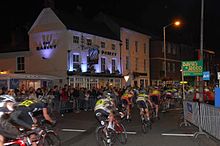 Shropshire Star Newport Nocturne Bike race 2006
Shropshire Star Newport Nocturne Bike race 2006
The area also has a rich motorsports heritage, with the Loton Park Hillclimb and Hawkstone Park Motocross Circuit situated near Shrewsbury. Shrewsbury Motocross Club has staged motocross events in the area for over 30 years. There is additionally an ice hockey club in the county, the Telford Tigers.
The county has a number of private and public golf courses, including the Church Stretton Golf Club, situated on the slopes of the Long Mynd. It is the oldest 18-hole golf course in Shropshire, opened in 1898, and one of the highest in the United Kingdom. There is one notable horse racing racecourse in Shropshire, near Ludlow, the Ludlow Racecourse.
One of the biggest one day events in Shropshire and the biggest one day cycle race in the UK is the Shropshire Star Newport Nocturne, held every four years it is Britain's only floodlit cycle race.[62]
The historic Wenlock Olympian Society Annual Games are held annually in Much Wenlock during the second weekend in July. A four-day festival, the Games include cricket, volleyball, tennis, bowls, badminton, triathlon, 10k road race, track and field events, archery, five-a-side football, veteran cycle events, clay pigeon shooting and a golf competition.
See also
- 7603 Salopia – an asteroid named after the county
- 53rd Regiment of Foot – former British Army regiment
- Shropshire Archives – collects and makes accessible archives and books relating to the county
- Etymological list of counties – list of name origins
- Shropshire Family History Society
- Diocese of Shrewsbury – Roman Catholic diocese which covers all of Shropshire
- Shropshire Star – local newspaper covering the county
- Shropshire Blue cheese
- Wenlock Olympian Society – organisers of the Wenlock Olympian Games, Live Arts Festival and Rock Band Showdown
References
- ^ "Table 8a Mid-2010 Population Estimates: Selected age groups for local authorities in the United Kingdom; estimated resident population.". Population Estimates for UK, England and Wales, Scotland and Northern Ireland, Mid-2010. Office for National Statistics. 3 June 2011. http://www.ons.gov.uk/ons/publications/re-reference-tables.html?edition=tcm%3A77-231847. Retrieved 1 October 2011.
- ^ upmystreet.com: Mark Pritchard[dead link]
- ^ upmystreet.com: Philip Dunne[dead link]
- ^ upmystreet.com: Daniel Kawczynski[dead link]
- ^ upmystreet.com: Owen Paterson[dead link]
- ^ upmystreet.com: David Wright[dead link]
- ^ a b Blandings: English Counties – broken link
- ^ SHROPS – What does SHROPS stand for? Acronyms and abbreviations by the Free Online Dictionary. Acronyms.thefreedictionary.com. Retrieved on 25 August 2011.
- ^ a b c [1][dead link]
- ^ statics.gov website[dead link]
- ^ Shrewsbury – Tourist Information & Accommodation for Shrewsbury, Shropshire.
- ^ Wrexham & Shropshire :: Telford.
- ^ Ironbridge Page on UNESCO World Heritage website. Whc.unesco.org (6 March 2007). Retrieved on 25 August 2011.
- ^ BBC – Shropshire – Features – Industrial Archeology.
- ^ Shropshire Hills AONB. Shropshire Hills AONB. Retrieved on 25 August 2011.
- ^ shropshirerocks.org: The Wrekin & The Ercall[dead link]
- ^ shropshirerocks.org: Brown Clee Hill[dead link]
- ^ shropshirerocks.org: The Stiperstones[dead link]
- ^ shropshirerocks.org: The Long Mynd[dead link]
- ^ shropshirerocks.org: Wenlock Edge[dead link]
- ^ Shropshire Council. Shropshire.gov.uk (15 July 2011). Retrieved on 25 August 2011.
- ^ website. Plantlife.org.uk. Retrieved on 25 August 2011.
- ^ Article on Shropshire. 1911encyclopedia.org (21 January 2009). Retrieved on 25 August 2011.
- ^ http. //www.britannica.com. Retrieved on 25 August 2011.
- ^ [2][dead link]
- ^ Shrewsbury Museums Service – Shrewsbury Castle & The Shropshire Regimental Museum. Shrewsburymuseums.com. Retrieved on 25 August 2011.
- ^ Secret Shropshire. Secret Shropshire. Retrieved on 25 August 2011.
- ^ Climate in Wales
- ^ About Shropshire Calverhall Village
- ^ County's name change colonel dies BBC News
- ^ Vision of Britain – Ancient county boundaries
- ^ http://www.wmra.gov.uk/documents/WMRA%20Green%20belt%5B1%5D.pdf
- ^ page 2[dead link]
- ^ "Shropshire – MSN Encarta". http://uk.encarta.msn.com/encyclopedia_781530177/Shrewsbury.html. Retrieved 24 February 2008.
- ^ Shropshire Routes to Roots | Sources and collections | Trade directories. .shropshire-cc.gov.uk (13 July 2007). Retrieved on 25 August 2011.
- ^ http://www.wellington-shropshire.gov.uk/NR/rdonlyres/68941C30-A7CB-44F3-822B-8B6D09E6932C/19217/Wellington.pdf
- ^ population of Madeley, Shropshire, England 2010. True Knowledge. Retrieved on 25 August 2011.
- ^ Shropshire – Your Place and Mine – Dawley. BBC. Retrieved on 25 August 2011.
- ^ What is the population of oakengates?. True Knowledge. Retrieved on 25 August 2011.
- ^ Oakengates lined up for huge revamp « Shropshire Star. Shropshirestar.com. Retrieved on 25 August 2011.
- ^ BBC Shropshire website Retrieved 10 September 2007. Bbc.co.uk (16 August 2011). Retrieved on 25 August 2011.
- ^ National Statistics Bridgnorth district parishes
- ^ Shrewsbury and Newport Canal Trust. Sncanal.org.uk. Retrieved on 25 August 2011.
- ^ "Last Wrexham-Shropshire-London train departs". BBC News. 28 January 2011. http://www.bbc.co.uk/news/uk-england-shropshire-12305519.
- ^ http. //www.discovershropshire.org.uk (26 September 2006). Retrieved on 25 August 2011.
- ^ Shropshire Towns – Towns in Shropshire, Shrewsbury, Ironbridge, Ludlow, Bridgnorth, Oswestry. Shropshiretourism.co.uk (21 March 2011). Retrieved on 25 August 2011.
- ^ 'Gateway to Wales'. British-towns.net. Retrieved on 25 August 2011.
- ^ a b Lords Hansard text for 20 Jul 200920 July 2009 (pt 0002). Publications.parliament.uk (20 July 2009). Retrieved on 25 August 2011.
- ^ Call to reopen Wellington to Stafford Railway line « Shropshire Star. Shropshirestar.com. Retrieved on 25 August 2011.
- ^ Telford Shopping Centre. Telfordshopping.co.uk. Retrieved on 25 August 2011.
- ^ Darwin Shopping Centre
- ^ Müller | Faqs[dead link]
- ^ RAF – Stations[dead link]
- ^ Contact Us. PDSA (29 July 2011). Retrieved on 25 August 2011.
- ^ a b Components may not sum to totals due to rounding
- ^ a b includes hunting and forestry
- ^ a b includes energy and construction
- ^ a b includes financial intermediation services indirectly measured
- ^ GCSE: Top comprehensive schools – The Times
- ^ Defra UK; ERDP – West Midlands ERDP Regional Chapter[dead link]
- ^ Cadfael Literature/ITV.com Cadfael Classic TV Profile http://www.itv.com/ClassicTVshows/crime/Cadfael/default.html
- ^ [3][dead link]
External links
- Shropshire at the Open Directory Project
- shropshirelive.com – News and information for Shropshire
- [4] – Wenlock Olympian Society
Ceremonial county of Shropshire Boroughs or districts Major settlements Rivers Topics - Geology
- Settlements
- History
- Museums
- Parliamentary constituencies
- Railways
Districts of the West Midlands Region Herefordshire 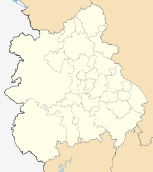
Shropshire Staffordshire Warwickshire West Midlands Birmingham · Coventry · Dudley · Sandwell · Solihull · Walsall · Wolverhampton
Worcestershire Bromsgrove · Malvern Hills · Redditch · Worcester · Wychavon · Wyre Forest
Unitary authorities of England Districts Bath and North East Somerset · Bedford · Blackburn with Darwen · Blackpool · Bournemouth · Bracknell Forest · Brighton and Hove · Bristol · Central Bedfordshire · Cheshire East · Cheshire West and Chester · Cornwall · County Durham · Darlington · Derby · East Riding of Yorkshire · Halton · Hartlepool · Herefordshire · Isle of Wight · Kingston upon Hull · Leicester · Luton · Medway · Middlesbrough · Milton Keynes · North East Lincolnshire · North Lincolnshire · North Somerset · Northumberland · Nottingham · Peterborough · Plymouth · Poole · Portsmouth · Reading · Redcar and Cleveland · Rutland · Shropshire · Slough · Southampton · Southend-on-Sea · South Gloucestershire · Stockton-on-Tees · Stoke-on-Trent · Swindon · Telford and Wrekin · Thurrock · Torbay · Warrington · West Berkshire · Wiltshire · Windsor and Maidenhead · Wokingham · York
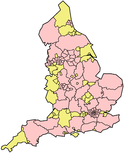
Councils Bournemouth · Cornwall · Herefordshire · Isle of Wight · Kingston upon Hull · Leicester · Middlesbrough · Northumberland · Nottingham · Poole · Rutland · Shropshire · Slough · Thurrock · Wiltshire
Categories:- Shropshire
- Unitary authorities of England
- Local government districts of the West Midlands (region)
- NUTS 3 statistical regions of the United Kingdom
Wikimedia Foundation. 2010.

